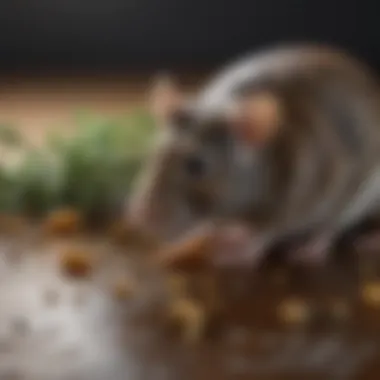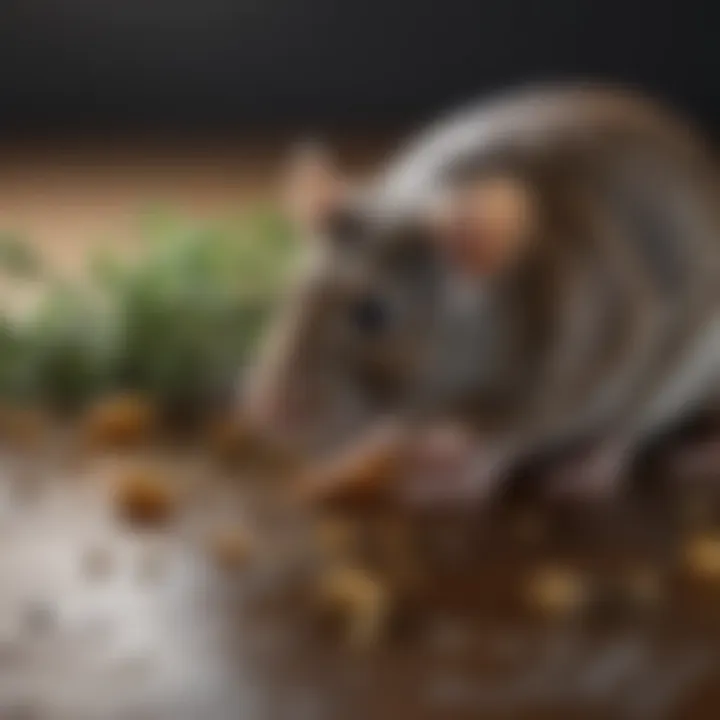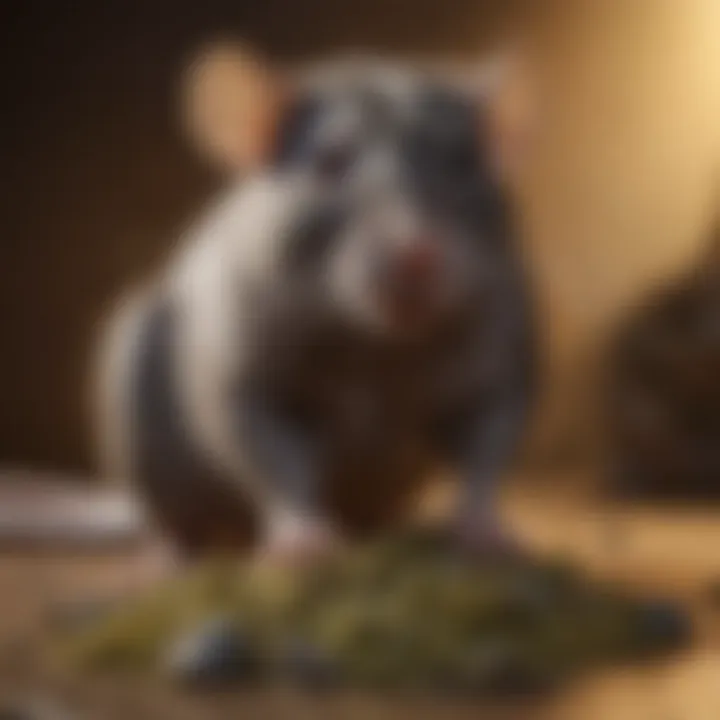Understanding Rat Olfactory Aversion: Key Scents They Hate


Intro
Rats are often seen as unwelcome guests in homes and properties. Their presence can signify more than just an annoyance; they can damage property and spread diseases. Understanding rats and their behaviors can play a crucial role in effective pest control. Among the various aspects of rat behavior, their sense of smell stands out as particularly powerful. This article aims to explore the olfactory preferences and aversions of rats, focusing on specific scents that deter these rodents. By understanding what odors rats hate, homeowners can utilize this knowledge in pest prevention and control methods.
Understanding the Pest
Rats belong to the group of rodents that have adapted well to living alongside humans. Learning more about their identification and life cycle can be essential for effective management and control strategies.
Identification
Common species of rats include the Norway rat and the roof rat. Both species have distinct characteristics. The Norway rat has a stocky body, small eyes, and a blunt nose, while the roof rat has a more slender body, larger ears, and a pointed snout. Knowing how to identify these rats can help in recognizing their signs of presence, such as droppings or chewed materials.
Life Cycle
Rats reproduce rapidly, which makes controlling their populations a challenge. A typical female rat can give birth to up to twelve pups every few weeks. The gestation period lasts about three weeks. Therefore, a small rat problem can quickly become large if not addressed timely. The rapid life cycle emphasizes the importance of understanding how scents can deter these creatures before they reproduce.
Pest Prevention Strategies
Effective pest prevention starts with modifying the environment. This can make it less habitable for rats and help stop their presence before it becomes a problem. Several strategic steps can be taken.
Environment Modification
To make properties less inviting to rats, consider removing potential food sources and nesting sites. This can include:
- Keeping pet food indoors and securely stored
- Ensuring trash bins are sealed
- Eliminating clutter in yards and basements
Creating a clean and tidy environment helps limit the availability of resources for rats.
Physical Barriers
Use physical barriers to prevent rats from accessing your home. This entails sealing gaps and holes, especially around pipes and wires. Hardware cloth can be effective to cover larger openings where rats might enter. Mind these locations, as entry points vary by species.
Control Methods
Should prevention fail, understanding control methods becomes necessary. There are various strategies to consider, focusing on both chemical and biological means.
Chemical Control
There are several commercial rodenticides available, yet these should be used cautiously. Always read labels and ensure products are safe for use in living areas. Baits can attract rats, making them susceptible to harmful substances. Proper placement of baits is critical.
Biological Control
Biological control methods include the introduction of natural predators like cats or certain dog breeds that are known to hunt rodents. These methods can help manage rat populations without harming the environment with chemicals. Such solutions not only deter rats but also maintain ecological balance.
The combination of olfactory aversions and these pest control strategies provides a comprehensive approach to managing rat populations effectively.
Understanding rat behaviors, particularly their response to different smells, plays a key role in pest management. By identifying smells that deter rats and implementing solid control techniques, homeowners can reclaim their spaces and keep these pests at bay.
Foreword to Rodent Olfactory Sensitivity
The olfactory sensitivity of rats plays a crucial role in their survival and behavior. Understanding how rats perceive scents can shed light on their feeding habits, social interactions, and even their breeding patterns. In many cases, the scents that rats detest can be used against them in pest control methods. Knowing which odors to exploit provides an edge for homeowners and pest management professionals alike.
The Importance of Smell in Rats


Rats are highly reliant on their sense of smell to navigate their environment. Their olfactory capabilities allow them to identify food sources and detect predators. This reliance makes them sensitive to certain odors that signal danger or unpalatable substances. For rats, smell is intertwined with survival instincts; they can associate specific smells with negative experiences, thereby leading to aversion over time.
Moreover, rats can communicate socially through scents. They leave pheromones to mark territory or signal reproductive status. This intricate use of smell indicates that odors have a significant impact on rat behavior, which is important to consider when developing pest management strategies.
Unique Features of the Rat Olfactory System
The olfactory system of a rat is specially adapted for effective scent detection. Rats possess an extensive array of olfactory receptors that can discern a vast range of smells. Research indicates that rats have roughly 1,200 different olfactory receptor genes. Some studies even suggest that rats can detect certain odors at incredibly low concentrations, making them expert scavengers.
Their anatomical structure further enhances this capability. The presence of a well-developed olfactory bulb allows for advanced processing of scents. When encountering a novel odor, rats can quickly learn to associate it with either safety or danger. This ability to adapt to scents is also why certain smells can be effective repellents.
In summary, understanding the nuances of rodent olfactory sensitivity is essential for both comprehending their behavior and effectively managing their populations. By leveraging the knowledge of specific scents that rats dislike, one can establish informed pest control practices that cater both to homeowner needs and pest management initiatives.
Common Odors That Rats Detest
Understanding the odors that rats avoid is essential for effective pest management. These distinct scents act as natural deterrents, making them valuable for homeowners seeking to safeguard their spaces from rodent infestation. By identifying specific odors that repulse rats, individuals can implement strategies that utilize these olfactory aversions. Not only does this knowledge reduce reliance on chemical repellents, but it also promotes a more environmentally friendly approach to pest control.
Citrus Scents
Rats typically find citrus scents, such as lemon and orange, highly unpleasant. The strong, zesty aroma is often used in pest repellents. Citrus oils can be advantageous because they not only detest the smell but also mask other food scents that might attract them. Homeowners can use citrus peels or specific essential oils in strategic locations. By placing these around entry points or areas where rats are seen, it's possible to create a barrier that makes spaces less inviting for these rodents.
Peppermint and Other Mint Scents
Peppermint is another scent rats dislike. The sharpness of peppermint oil is particularly effective. Many people use this oil as a natural repellent. Additionally, other mint family members, like spearmint, offer similar deterrent properties. Incorporating these scents in home cleaning solutions or diffusers can help to reduce rat presence. Simple solutions such as cotton balls soaked in peppermint oil can be placed in areas prone to infestation to help keep rats at bay.
Strong Spices: Clove and Cinnamon
Clove and cinnamon are strong spices that rats tend to avoid. Both have intense odors that can overwhelm a rat's sensitive olfactory receptors. Ground clove and cinnamon can be sprinkled in areas frequented by rats. Their natural presence in households also makes them easy to incorporate into pest management strategies. Many commercial pest control products utilize these spices as ingredients, effectively combining natural repellent qualities with other pest control methods.
Vinegar and Garlic
Both vinegar and garlic produce pungent scents that rats find intolerable. White vinegar can be combined with water and sprayed in suspected rat hotspots. The strong aroma not only helps to repel rats but also serves as a natural disinfectant. Garlic, when used in its raw form, can deter rats effectively. This scent can be as simple as placing crushed garlic cloves in strategic areas. Together, vinegar and garlic can form a powerful duo in keeping rat populations under control.
Biological Basis of Odor Aversion
Understanding the biological foundation of odor aversion in rats is crucial, as it informs how these animals interact with their environment. Smell plays a significant role in the survival of rats, influencing their behaviors in food selection, predator detection, and mate choice. Recognizing which scents trigger aversion can enable more effective control methods for pest management. This section examines the evolutionary context and neurological mechanisms that underpin rats' reactions to various odors.
Evolutionary Aspects
From an evolutionary standpoint, the ability to detect and avoid harmful substances has allowed rats to thrive in diverse environments. Rats possess a highly developed olfactory system which has evolved to help them identify food sources while steering clear of potential dangers. The ability to discern between beneficial and harmful smells is a trait honed over generations.
- Key Adaptations:
- Rats have developed heightened sensitivity to bitter and sour odors, which often signal toxicity in plants and decaying matter.
- Certain scents, like citrus and mint, have been linked to repulsive experiences that deter these creatures from consuming dangerous substances.
This evolutionary development highlights the need for rats to quickly adapt to their surroundings. Their survival often hinges on their ability to perceive and react to an ever-changing landscape filled with varying odors.
Neurological Impacts of Smell
The neurological processing of smell in rats is complex and involves several areas of the brain. The olfactory bulbs, which are responsible for processing odor information, are particularly large in rats compared to other mammals. This adaptation underscores the importance of smell in their daily functions.
- Olfactory Pathway:
- Information captured by olfactory receptors is transmitted directly to the olfactory bulb.
- Signals are then relayed to the amygdala and hippocampus, structures associated with emotion and memory.


This connection between smell and emotion may explain why certain scents can provoke strong aversions. A rat that has a negative experience linked to a specific odor is likely to avoid it in the future. The association of odor with a negative outcome creates a learned aversion, which can persist over time.
"Research in olfactory aversion shows that rats can learn from their experiences—smell is more than a simple cue; it is tied to their survival strategies."
Practical Applications in Pest Control
The application of scent-based strategies in pest control is an emerging area of interest among homeowners. Utilizing the knowledge of odors that rats abhor can lead to effective and humane methods to manage these infestations. Understanding how these odors function not only enhances pest control efforts but also offers benefits that align with environmentally friendly practices. These practical applications focus on operational efficiency, ethical considerations, and cost-effectiveness, proving significant in contemporary pest management.
Using Odors in Traps
Incorporating unpleasant scents into traps is a straightforward yet effective method for capturing or deterring rats. By strategically selecting odors that rats hate, such as strong citrus or peppermint, traps can become more proficient in their function. These scents can mask the lure of food, making traps more appealing as they exploit the rat's olfactory aversions. A well-designed trap that incorporates these odors not only helps to ensure higher capture rates but also reduces the chance of rats getting accustomed to the traps over time.
- Key Considerations:
- Ensure that the traps are placed in high-traffic areas.
- Change the scents periodically to maintain their effectiveness.
By integrating natural aversive scents, pest control traps can attain a higher degree of efficiency while also promoting humane capture methods.
Creating Natural Repellents
Natural repellents can be produced using common household ingredients, making them accessible and safe for regular use. Ingredients such as vinegar and clove oil can be combined to create solutions that deter rats from entering specific areas. Spraying or applying these natural repellents in targeted zones can act as a barrier.
- Recipe Example for a Natural Repellent:
- Shake well and spray in areas where rat activity is evident.
- Combine 1 cup of water with 1 cup of vinegar and several drops of clove oil.
This natural approach not only helps in managing unwanted rodent populations but also avoids the risks associated with chemical repellents, making it suitable for families and pets.
Strategies for Homeowners
Homeowners can adopt various strategies to utilize scent-based deterrents effectively.
- Routine Application: Regularly applying the natural repellents and ensuring areas are clean and free of food scraps can significantly reduce the likelihood of attracting rats.
- Maintaining a Clean Environment: Keeping living spaces tidy eliminates potential food sources, largely reducing the rats’ motivation to invade.
- Combination of Methods: Using both traps and natural repellents together can create a more comprehensive pest control strategy. The combination leverages the olfactory aversion rats have towards certain scents, enhancing the effectiveness of the overall approach.
Each of these strategies not only fosters an effective pest management environment but also encourages sustainable practices. Homeowners can thus enjoy living spaces free of rodents while employing methods that align with their ethical values.
Comparative Analysis with Other Rodents
The study of olfactory aversion in rats not only enhances our understanding of their behavior but also allows for a comparative analysis with other rodent species. This approach reveals essential differences in olfactory sensitivity and behavioral patterns across species. Such insights hold significant importance for pest control strategies. By understanding what other rodents, like mice and squirrels, dislike, effective methods and tactics can be tailored for pest management.
Differences Between Rats and Mice
Rats and mice are both common rodent pests, yet they exhibit differing reactions to various odors. Rats often show heightened sensitivity to certain scents that act as deterrents. For example, citrus, peppermint, and strong spices have been noted to repel rats. Conversely, mice may not respond in the same manner to these smells. Instead, mice often display a higher resilience to strong fragrances, making them less deterred by odors that would typically affect rats.
- Olfactory Receptors: Rats possess a larger number of olfactory receptors compared to mice. This anatomical difference means that their sense of smell is more acute.
- Behavioral Responses: When faced with unpleasant smells, rats tend to change their foraging behavior and avoid areas where they encounter specific odors. Mice, however, might continue to explore these areas unless the scent is especially strong.
In pest control contexts, understanding these differences assists homeowners in choosing the right scents for effective deterrence. This knowledge ensures that strategies are not only effective but also tailored to the specific type of rodent being addressed.
Behavioral Patterns in Squirrels and Other Rodents
Squirrels and other rodents display distinct behavioral patterns in response to olfactory stimuli. They, too, utilize their sense of smell for navigation and foraging. However, their reactions to similar smells can vastly differ from those of rats.
- Squirrels: These rodents rely on their sense of smell to identify food and potential threats. When it comes to strong scents, squirrels might be less deterred than rats. This difference can lead to greater challenges for pest control efforts targeting multiple rodent species.
- Interactions with Environment: Other rodents may not only react to smells differently but can also adapt their behaviors based on their environment. Understanding these nuances can aid pest controllers in developing comprehensive strategies.


By conducting a thorough comparative analysis of olfactory aversions among rodents, pest management professionals can refine their approaches. The insights derived from these behaviors can be essential in predicting rodent activity and optimizing scent-based control measures.
"An understanding of olfactory responses in rodents provides necessary tools for effective pest management in diverse environments."
Limitations of Scent-Based Control
While utilizing scent as a pest control method has its advantages, understanding its limitations is equally crucial. Scent-based strategies may not always yield the desired results. Factors such as the effectiveness of specific odors, environmental conditions, and the behavioral flexibility of the rats can significantly influence the outcomes of these methods.
Factors Affecting Efficacy
The efficacy of scent-based control often depends on various factors. For example:
- Concentration of Odors: Higher concentrations of a scent may be necessary to repel rats effectively. If the concentration is too low, it may not trigger a strong aversive response.
- Environmental Conditions: Weather and surrounding elements can affect how scents disperse. Rain, humidity, and wind all play a role in how well an odor can be detected.
- Duration of Exposure: Repeated exposure to the same scents can lead to habituation in rats. When rats become accustomed to a particular odor, its effectiveness as a repellent may diminish over time.
These factors suggest that simple application of certain scents may not always provide the expected deterrence.
Behavioral Adaptations of Rats
Rats are remarkably adaptable creatures. This adaptability can compromise the success of scent-based methods. Key aspects include:
- Habituation: As mentioned, rats can become accustomed to specific scents, reducing their aversion over time. This process of habituation is essential to understand when implementing scent-based controls.
- Exploratory Behavior: Rats are curious animals. They may explore areas where unpleasant odors are present, leading them to discover food sources despite the scent.
- Variability in Individual Sensitivity: Not all rats react the same way to specific scents. Some may have heightened sensitivity, while others may show minimal response, complicating the predictability of scent-based deterrents.
Understanding these behavioral adaptations is vital for anyone considering scent as a method for rat control. They illustrate how relying solely on scent-based strategies can be ineffective.
Scent-based control methods must be part of an integrated pest management strategy, taking into account the various factors and behavioral traits of rats to achieve optimal results.
Future Directions in Research
Research on rat olfactory aversion is an evolving field. Understanding which smells repel rats can lead to more effective pest control methods. As scientists uncover the specifics of rat olfaction, it becomes easier to develop targeted strategies that minimize rodent populations in homes.
Emerging Technologies in Pest Control
New technologies are at the forefront of pest management. For example, electronic devices that emit ultrasonic waves may deter rats. These devices can be integrated with scent-based methods. Combining olfactory aversion with technology can enhance effectiveness. Innovations like these do not rely solely on chemical repellents, which may have environmental impacts.
- Smart Traps: These traps can be equipped with sensors to detect movement, using real-time data to optimize catch rates.
- Biodegradable Repellents: Research is ongoing into creating plant-based repellents that are effective yet safe for the environment.
- Remote Monitoring Systems: These allow homeowners to track rat activity without being present, increasing the efficiency of pest control operations.
Leveraging these technologies, pest control can become more precise and less hazardous.
Potential for Genetic Studies on Olfaction
Genetic research offers insights into the sensory systems of rats. By exploring gene expression in relation to smell, researchers can identify why certain odors trigger aversion. This can lead to developing specially designed scents that exploit these traits.
Investigations might focus on:
- Olfactory Gene Mapping: Understanding which genes regulate smell in rats could provide pathways to creating unique repellents.
- Behavioral Genetics: Knowing how genetic variations influence behavior can inform more personalized pest control strategies.
- Genetic Engineering: Future research may push into gene editing to alter olfactory receptors in rodents, potentially reducing their attraction to harmful areas.
The intersection of genetic studies and olfactory aversion could revolutionize the way we approach pest control, providing both ecological and behavioral solutions.
The End
The conclusion is a pivotal section that encapsulates the essence of the subject matter discussed throughout the article. It serves to summarize the insights garnered about rat olfactory aversions, emphasizing the significance of understanding these factors in real-world pest management. By clarifying which specific scents rats tend to avoid, we can glean actionable strategies that homeowners and pest control professionals can adopt.
Summary of Key Findings
In reviewing the key findings, it becomes clear that rats possess unique olfactory sensitivities that can be leveraged for effective pest control. The research illustrates that certain odors, such as citrus and peppermint, act as natural deterrents. This is essential knowledge for anyone looking to manage rat populations without resorting to harmful chemicals.
Moreover, the biological and neurological basis of these aversions underscores why these scents are so effective. Evolution has led rats to develop a heightened sense of smell, aiding their survival. Understanding these biological mechanisms allows for more strategic pest management practices.
Practical Implications for Pest Management
The implications of this research are manifold. Homeowners can utilize the insights regarding rat scent aversions to create safer and more effective pest control measures. By using simple household items like vinegar, garlic, and mint, residents can craft natural repellents to deter rats from invading their spaces.
In addition, integrating these odors into traps can enhance their effectiveness. This provides an environmentally-friendly alternative to traditional methods, which often involve toxic chemicals.
In summary, the strategic application of scent aversions not only contributes to effective pest management but also promotes a safer living environment. Awareness of this topic is crucial for those wanting to keep their homes rat-free and healthy.







